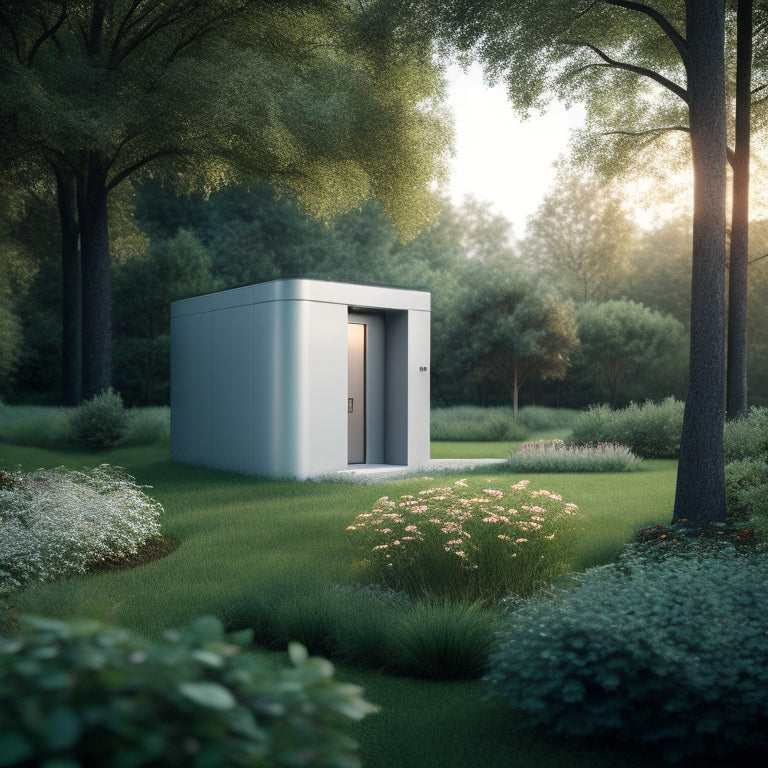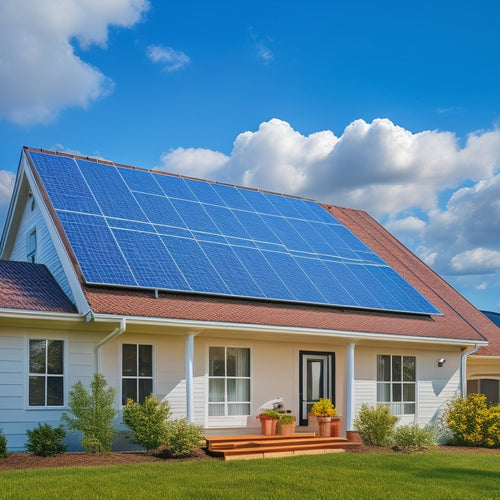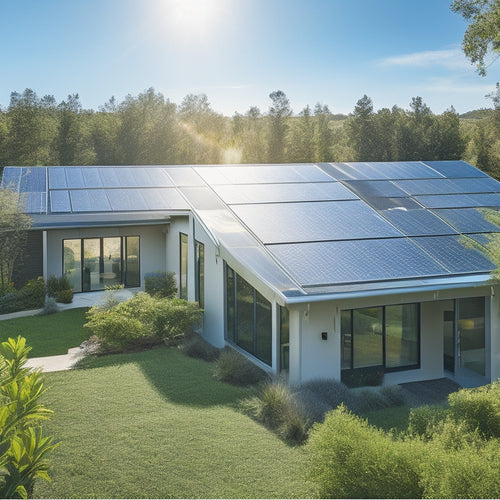
Store Your Own Home Energy With Ease
Share
You can store your own home energy with ease by designing a customized system that optimizes your energy usage, selects the right battery type, and integrates with your existing infrastructure. Evaluate your energy usage to identify areas for improvement, and consider factors like local climate conditions and appliance wattage. Choose a battery type that suits your needs, assessing pros and cons like energy density and lifespan. By following DIY solar panel installation tips and maximizing your energy storage capacity, you can achieve true energy independence. Now, take the next step to access the full potential of your energy storage system.
Overview
- Evaluate energy usage to identify areas for improvement and optimize load calculations for accurate appliance wattage assessment.
- Choose the right battery type based on factors like energy density, lifespan, and total cost of ownership, including maintenance and replacement.
- Consider integrating home automation systems to enhance energy consumption management and streamline energy needs.
- Select energy-efficient batteries with high depth of discharge (DOD) and perform regular maintenance to maximize energy storage capacity.
- Monitor energy usage in real-time to understand patterns, identify optimization opportunities, and achieve true energy independence.
Simplify Your Energy Storage Needs
You're likely no stranger to the complexities of home energy storage systems, but finding the right solution can be overwhelming. With so many options available, it's crucial to simplify your energy storage needs.
Start by evaluating your energy usage and identifying areas where you can improve energy efficiency, such as optimizing your load calculations energy usage assessment to determine the total wattage of your appliances.
Consider integrating home automation systems to optimize your energy consumption, and also factoring in local climate conditions that affect your solar panel system's performance. This will help you determine the right size and type of energy storage system for your home.
By streamlining your energy needs, you'll be able to find a solution that meets your unique requirements, providing you with the freedom and independence you desire.
A well-designed energy storage system won't only reduce your energy bills but also increase your energy independence.
Choosing the Right Battery Type
With your energy needs assessed and simplified, it's time to focus on the heart of your home energy storage system: the battery. You'll need to choose the right type to guarantee reliable, efficient energy storage.
Lithium-ion batteries offer several advantages, including high energy density, long lifespan, and low maintenance. However, they can be expensive.
Lead-acid batteries, on the other hand, are more affordable but heavier, larger, and less efficient.
When selecting a battery, consider factors like battery longevity, energy density, and your specific energy needs. It's crucial to evaluate the total cost of ownership, including upfront, maintenance, and replacement costs rural energy needs, as well as the performance and maintenance requirements of each option.
Weigh the pros and cons of each option to make an informed decision. By choosing the right battery type, you'll be one step closer to achieving energy independence and freedom from the grid.
DIY Solar Panel Installation Tips
About 90% of solar panel installations are typically mounted on rooftops, making it vital to guarantee a secure and efficient installation. To ascertain this, you'll need to obtain necessary installation permits from your local authorities before starting the project.
When installing your solar panels, make sure to follow the manufacturer's instructions and take necessary safety precautions to avoid electrical shock or falls. Properly securing the panels to your roof will also prevent damage from strong winds or weather conditions.
Conducting an energy assessment before installation can also help determine the ideal system size and layout for your energy needs. Analyzing past electricity bills for average daily usage can provide significant understandings for ideal solar panel performance.
Regular solar panel maintenance is also essential to guarantee optimal energy production. You should clean the panels regularly to remove dirt and debris that can reduce energy output.
Maximizing Energy Storage Capacity
Optimizing your solar panel installation is just the first step in utilizing renewable energy.
Now, it's time to think about maximizing your energy storage capacity. You'll want to guarantee you're getting the most out of your system by selecting the right storage solutions. Look for energy-efficient batteries with a high depth of discharge (DOD) to minimize waste and maximize your energy reserve.
When choosing a deep cycle battery, consider options like the Renogy Deep Cycle Battery that offer performance, durability, and affordability for off-grid systems.
Additionally, regular maintenance is essential for battery longevity, including electrolyte checks and proper charging.
Consider your energy usage patterns and size your storage system accordingly. A well-designed system will provide you with a reliable source of power, even during outages or periods of low energy production.
Monitoring Your Energy Usage Effectively
Two key aspects of achieving energy independence are maximizing energy storage capacity and monitoring your energy usage effectively.
When you monitor your energy consumption, you gain understanding into your usage patterns, identifying areas where you can optimize your energy usage. This allows you to make informed decisions about your energy storage system, ensuring it's sized correctly to meet your needs.
By tracking your energy usage, you'll be able to identify peak usage times, optimize your system's performance, and make adjustments to reduce your energy consumption.
With real-time monitoring, you'll have complete control over your energy usage, giving you the freedom to live off the grid and enjoy true energy independence.
Frequently Asked Questions
Can I Store Energy From Non-Solar Sources Like Wind or Hydro Power?
You can store energy from non-solar sources like wind or hydro power using advanced systems designed for wind energy storage and hydro power storage, giving you the freedom to capture and employ these renewable resources efficiently.
Are Energy Storage Systems Compatible With Existing Electrical Infrastructure?
You'll find that energy storage systems seamlessly integrate with existing electrical infrastructure, ensuring grid integration and optimizing system efficiency, allowing you to capture and store power from various sources, including wind and hydro, with precision and control.
How Long Do Energy Storage Systems Typically Last Before Replacement?
You'll find that energy storage systems typically last around 10-15 years, depending on factors like usage and maintenance, before needing replacement, with battery longevity varying by brand and type, affecting overall replacement costs.
Can I Use Energy Storage Systems for Both Home and Electric Vehicle Charging?
Imagine opening a dual-purpose energy haven; yes, you can use energy storage systems for both home and electric vehicle charging, leveraging advanced battery types like lithium-ion and optimizing charging efficiency to fuel your freedom.
Are Energy Storage Systems Prone to Overheating or Fire Hazards?
You're right to wonder if energy storage systems are prone to overheating or fire hazards; thankfully, advanced thermal management and rigorous battery safety standards guarantee these risks are mitigated, giving you peace of mind and reliable performance.
Ready to Buy
You've ditched the grid, utilizing the sun's power to fuel your home. But without a smart energy storage system, those precious electrons will vanish into thin air. Now, you've got the know-how to simplify your energy storage needs, select the right battery type, and even install solar panels like a pro. By maximizing capacity and monitoring usage, you'll be the expert of your energy domain. The freedom to store your own energy has never felt so liberating - or sustainable.
Related Posts
-

Cost of Solar Panel Installation
You can expect to pay between $15,000 and $30,000 or more for a typical solar panel installation, depending on the sy...
-

Designing a Green Roof for Maximum Energy Efficiency
Designing a green roof for maximum energy efficiency involves several key strategies. Start by selecting native, drou...
-

Installing Metal Solar Roofs for Maximum Energy Efficiency
Installing metal solar roofs can drastically enhance your home's energy efficiency and durability. These roofs withst...


